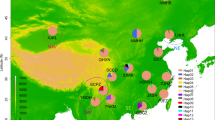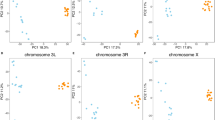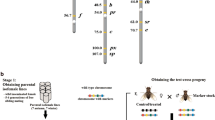Abstract
The importance of natural selection in determining spatial patterns of allele frequencies remains unclear despite many geographical surveys of allele frequency variation in a variety of organisms1. Most patterns can be interpreted as a result of either selective or stochastic processes, depending on the assumptions made about population size and migration rate2. One line of evidence that could refute the stochastic explanation would be the discovery of parallel patterns of geographical variation for shared polymorphisms in different sibling species3. The present study demonstrates such patterns for the esterase-6 (Est6) and phosphoglucomutase (Pgm) polymorphisms of Drosophila simulans and Drosophila melanogaster. These two species share the same latitudinally correlated patterns of Est6 allele frequencies in Australasia, North America and Europe, but are more geographically uniform for Pgm allele frequencies on all three continents.
This is a preview of subscription content, access via your institution
Access options
Subscribe to this journal
Receive 51 print issues and online access
$199.00 per year
only $3.90 per issue
Buy this article
- Purchase on Springer Link
- Instant access to full article PDF
Prices may be subject to local taxes which are calculated during checkout
Similar content being viewed by others
References
Nevo, E. Theor. Pop. Biol. 13, 121–177 (1978).
Lewontin, R. C. The Genetic Basis of Evolutionary Change (Columbia University Press, New York, 1974).
Harrison, R. G. Nature 266, 168–170 (1976).
Anderson, P.R. in Genetic Studies of Drosophila Populations (eds Gibson, J.B. & Oakeshott, J. G.) 237–250 (Australian National University Press, Canberra, 1981).
Oakeshott, J.G., Chambers, G.K., Gibson, J.B. & Willcocks, D.A. Heredity 47, 385–396 (1981).
Oakeshott, J. G. et al. Evolution 36, 88–96 (1982).
Oakeshott, J. G., Chambers, G. K., Gibson, J.B., Eanes, W.F. & Willcocks, D.A. Heredity 50, 67–72 (1983).
Oakeshott, J. G., Gibson, J. B. & Willcocks, D.A. Theor. appl. Genet. 65, 191–196 (1983).
Oakeshott, J. G., McKechnie, S. W. & Chambers, G. K. Genetica (in the press).
Knibb, W. R., Oakeshott, J. G. & Gibson, J. B. Genetics 98, 833–847 (1981).
David, J. R. & Tsacas, L. C.r. somm. Séonc Soc. Biogeogr. 57, 11–26 (1980).
Eisses, K. T., van Dijk, H. & van Delden, W. Evolution 33, 1063–1068 (1979).
Triantaphyllidis, C. J. Hered. 64, 69–72 (1973).
O'Brien, S. & MacIntyre, R. Am. Nat. 103, 97–113 (1969).
Triantraphyllidis, C. D., Panourgias, J. N., Scouras, Z. G. & Ioannides, G. C. Genetica 51, 227–231 (1980).
Triantaphyllidis, C. D., Scouras, Z. G., Panourgias, J. N. & Ioannides, G. C. Genetica 58, 129–136 (1982).
Cabrera, V.M., Gonzalez, A.M., Larruga, J.M. & Gullon, A. Genetica 59, 191–201 (1982).
Kojima, K-I., Gillespie, J. & Tobari, Y. N. Biochem. Genet. 4, 627–637 (1970).
Steiner, W. W. M., Sung, K. C. & Paik, Y. K. Biochem. Genet. 14, 495–506 (1976).
Berger, E. M. Genetics 66, 677–683 (1970).
Ohnishi, S., Leigh Brown, A. J., Voelker, R. A. & Langley, C. H. Genetics 100, 127–136 (1982).
Ashburner, M. & Lemeunier, L. Proc. R. Soc. B193, 137–157 (1976).
de Albuquerque, C. M. R. & Napp, M. Genetics 98, 399–407 (1981).
Endler, J. A. Geographic Variation, Speciation and Clines (Princeton University Press, New Jersey, 1977).
Zera, A. J., Koehn, R. K. & Hall, J. G. in Comprehensive Insect Physiology, Biochemistry and Pharmacology Vol. 10 (eds Kerkut, G. A. & Gilbert, L. I.) Ch. 18 (Pergamon, New York, 1983).
Dickinson, W.J. & Sullivan, D.T. Gene-Enzyme Systems in Drosophila 130–136 (Springer, Berlin, 1975).
Cochrane, B. J. & Richmond, R. C. Genetics 93, 461–478 (1979).
Trippa, G., Catamo, A., Lombardozzi, A. & Cicchetti, R. Biochem. Genet. 16, 299–305 (1978).
Leigh Brown, A. J. & Ish-Horowicz, D. Nature 290, 677–682 (1981).
Franklin, I. R. & Lewontin, R. C. Genetics 65, 701–734 (1970).
Author information
Authors and Affiliations
Rights and permissions
About this article
Cite this article
Anderson, P., Oakeshott, J. Parallel geographical patterns of allozyme variation in two sibling Drosophila species. Nature 308, 729–731 (1984). https://doi.org/10.1038/308729a0
Received:
Accepted:
Issue Date:
DOI: https://doi.org/10.1038/308729a0
This article is cited by
-
Mutational mechanisms, phylogeny, and evolution of a repetitive region within a clock gene ofDrosophila melanogaster
Journal of Molecular Evolution (1996)
-
Causes and consequences of esterase 6 enzyme activity variation in pre-adult Drosophila melanogaster
Heredity (1994)
-
Associations of esterase 6 allozyme and activity variation with reproductive fitness inDrosophila melanogaster
Genetica (1994)
-
Clinal variation and selection of MDH allozymes in honey bee populations
Experientia (1994)
-
Conservation and change in structural and 5′ flanking sequences of esterase 6 in siblingDrosophila species
Genetica (1993)
Comments
By submitting a comment you agree to abide by our Terms and Community Guidelines. If you find something abusive or that does not comply with our terms or guidelines please flag it as inappropriate.



